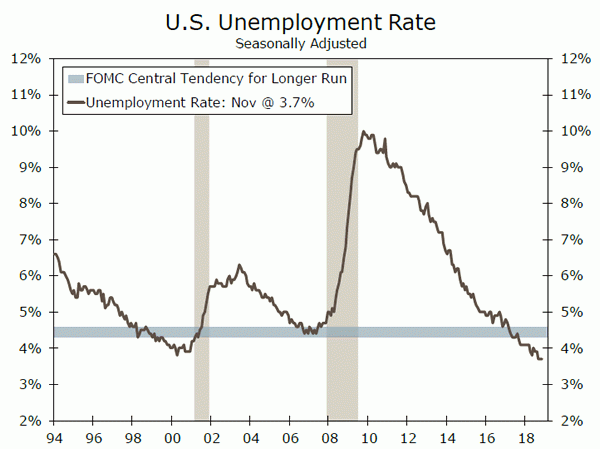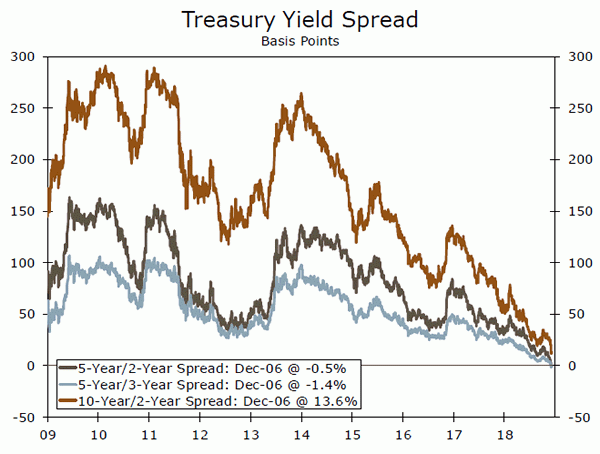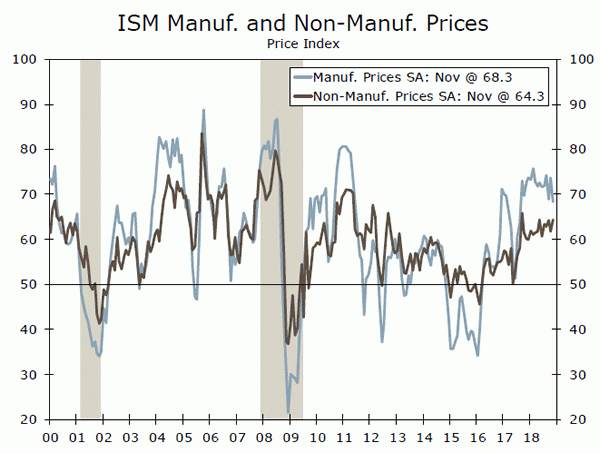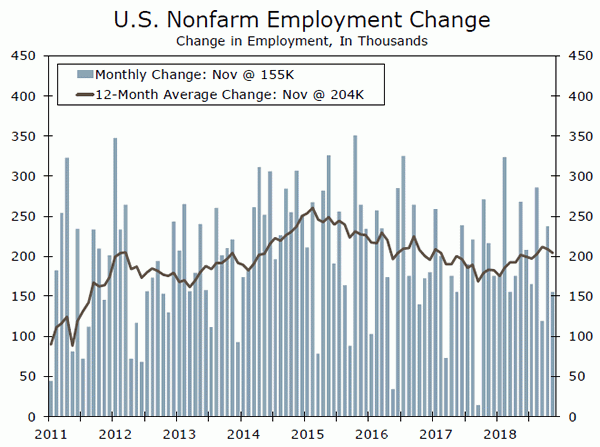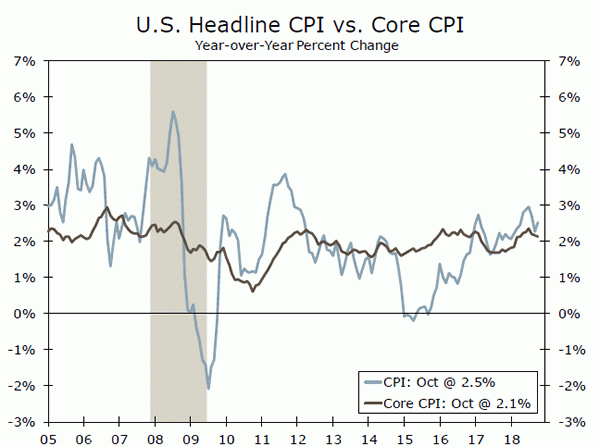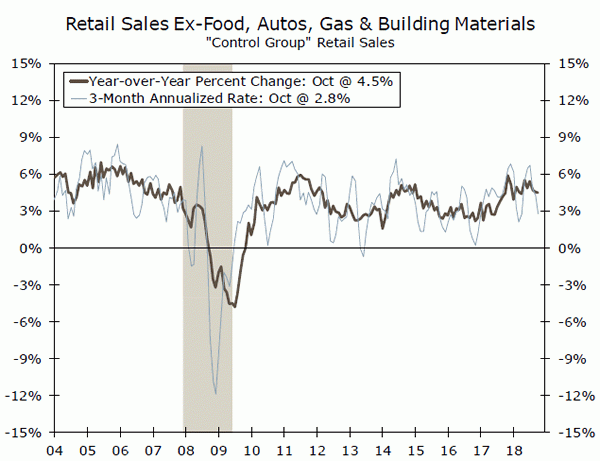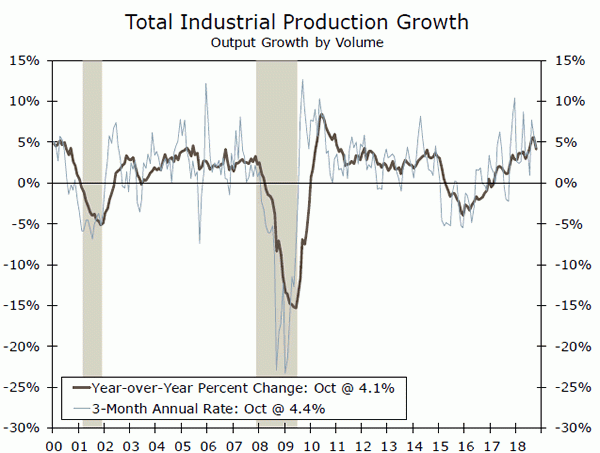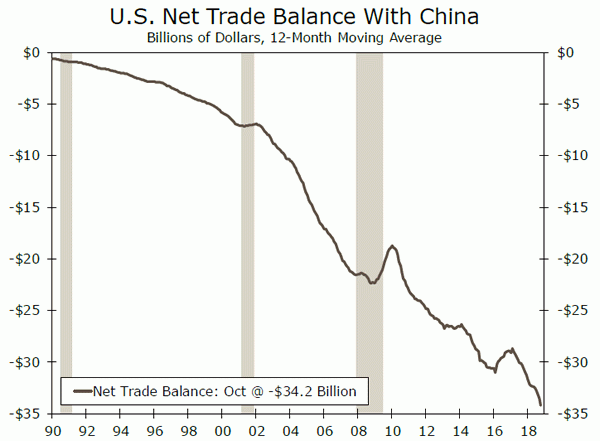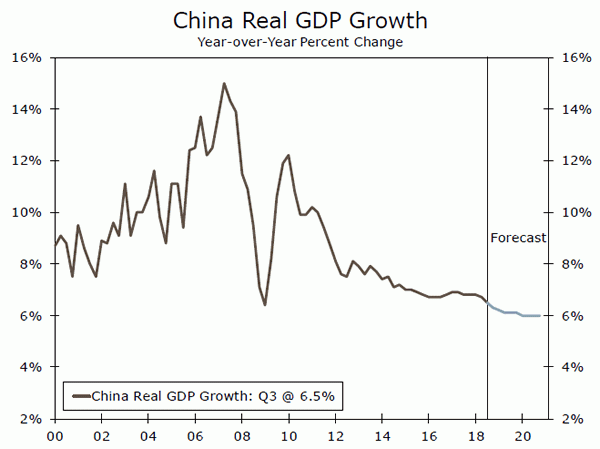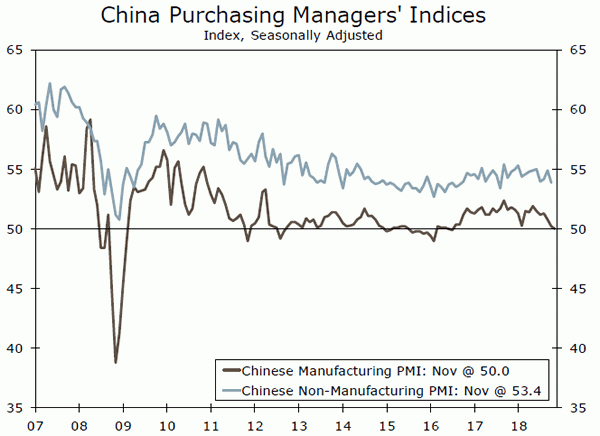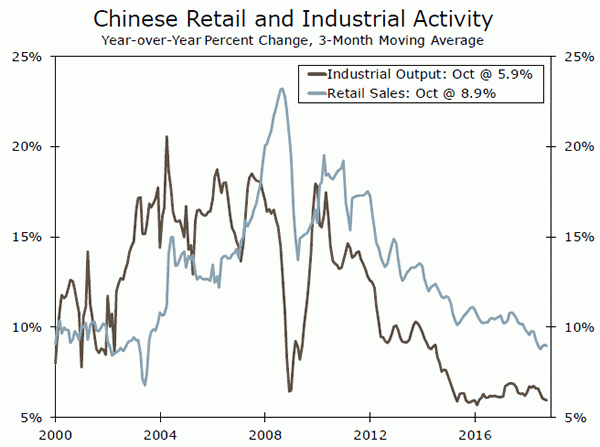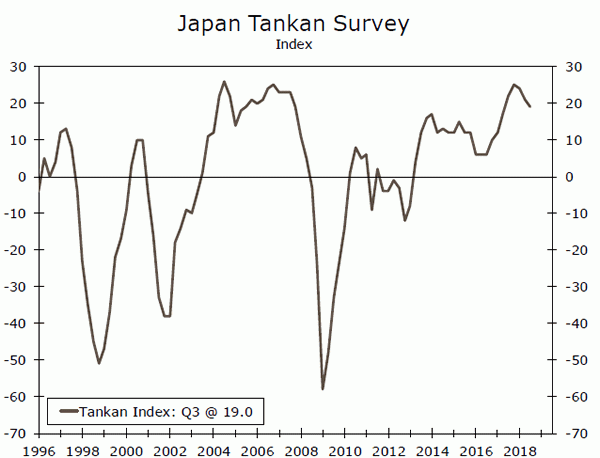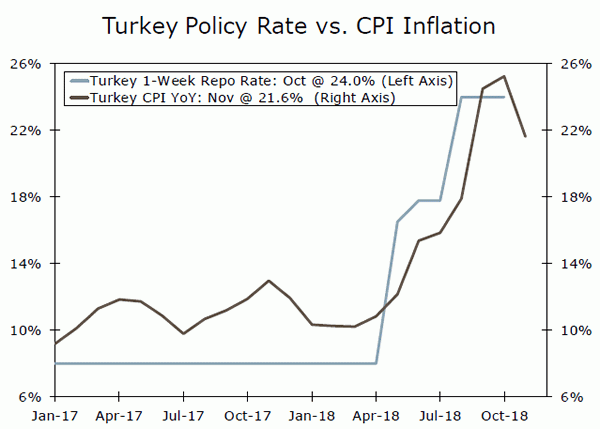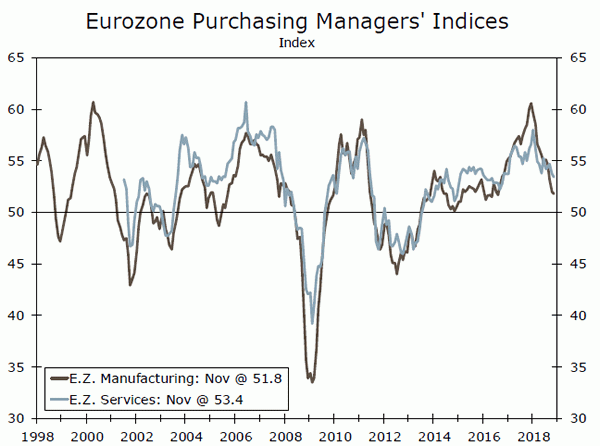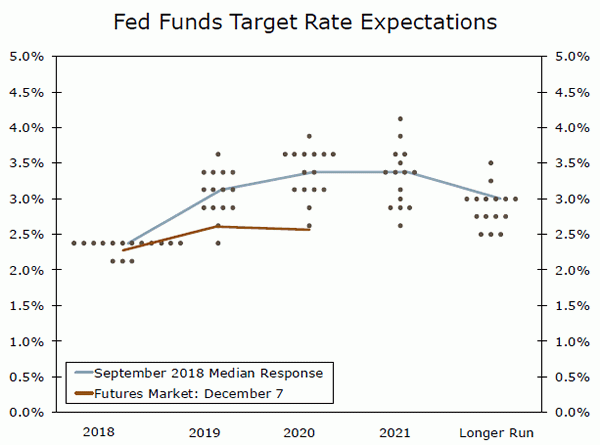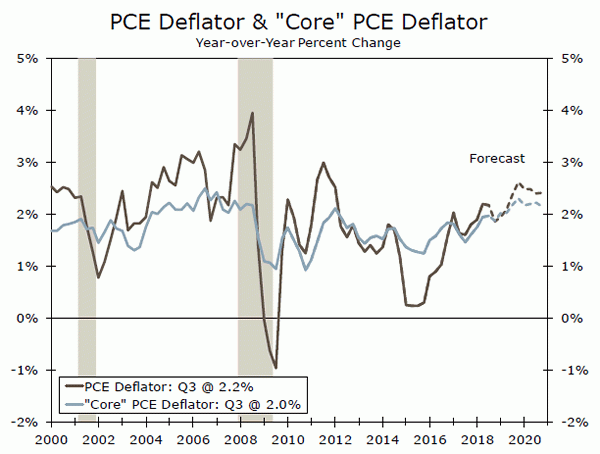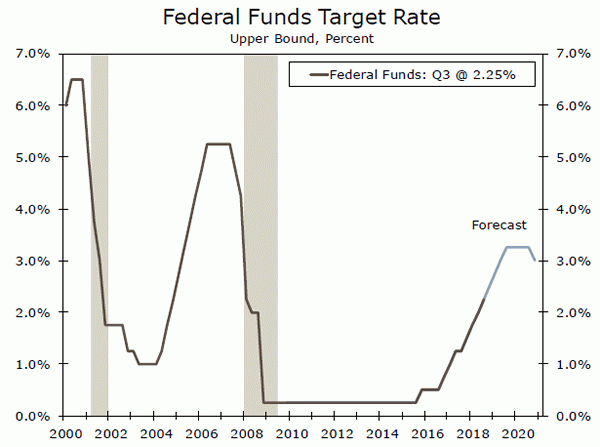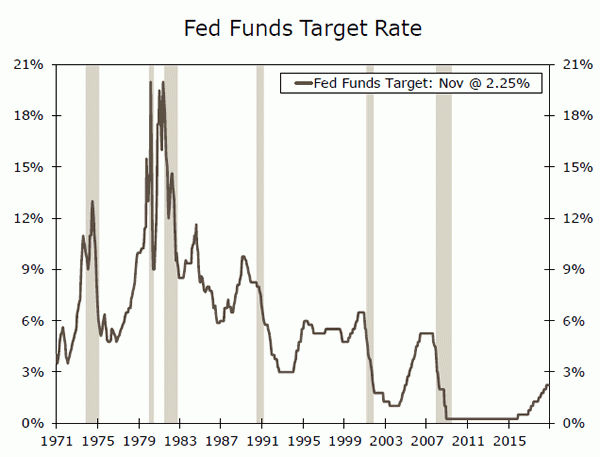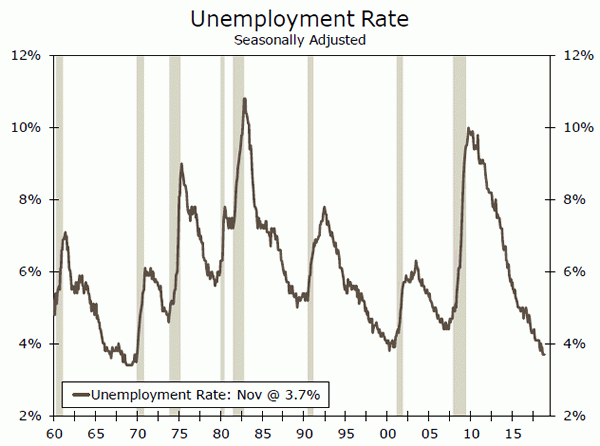U.S. Review
Despite Market Jitters, Fed to Raise Rates in December
- An ephemeral trade truce, the inversion of the front-end of the yield curve and a softer than expected jobs report fueled fears of the economy slowing. But, with economic data this week suggesting a relatively healthy economy, we still expect the Fed to raise rates at its meeting on December 19.
- The ISM manufacturing and non-manufacturing surveys point to robust activity. Nonfarm payrolls rose just 155,000 in November, and the unemployment rate held steady at 3.7%. But, while this report points to some softening in the labor market, we note that other measures suggest the overall jobs picture remains relatively strong.
Despite Market Jitters, Fed to Raise Rates in December
The front-end of the yield curve inverted this week, with two- and three-year Treasury yields rising above the five-year yield. Given that many analysts view an inversion as an omen for an economic downturn, this week’s inversion brought heightened sensitivity among markets to the increased probability of a recession on the horizon. We note, however, that while the yield curve has inverted prior to each recession since 1970, it has done so at varying degrees of lead time–from 8-23 months. Also, the spread between the twoand 10-year Treasury yields, a more widely recognized spread, has flattened recently, but has not yet inverted.
Given that we are in the tenth year of the current expansion, which is the second longest on record, the late-cycle dynamic that this inversion suggests is not wholly surprising. Coincident measures of growth remain healthy but have come off the boil recently, while some forward-looking measures of growth have weakened. We look for a moderation in economic growth over the next two years, but are not forecasting a recession. Even as the Fed has moved away from a pre-determined policy path and become more data dependent, we do not expect this inversion to deter it from raising rates at its December meeting.
Economic data this week suggest a relatively healthy economy. One area of uncertainty continues to be trade turmoil between the United States and China. A meeting between President Trump and President Xi at the G-20 summit resulted in a 90-day ceasefire to allow for negotiations. While you can find our full analysis of the agreement in our International Review section on Page 4, here we highlight this temporary truce has not added certainty to the domestic outlook. Markets turned bearish this week as the potential for further escalation remains, while producers continue to feel the sting of tariffs in the form of higher input costs.
Fresh data from the Institute for Supply Management (ISM) this week pointed to robust activity in both the manufacturing and nonmanufacturing sectors in November. The manufacturing prices paid component fell sharply, while the non-manufacturing measure continued to trend higher. The anecdotal evidence from respondents of both surveys nonetheless suggests that tariffs are having a wide-ranging impact across industries, such as higher input costs weighing on producers. The manufacturing and nonmanufacturing surveys reported generally strong orders and rising backlogs. Both employment components remain at lofty levels, which was partially evident in this morning’s nonfarm payrolls release for November, with manufacturing adding 27,000 jobs.
But, nonfarm payrolls missed expectations in November, adding just 155,000 jobs over the month and with revisions to the prior two months also subtracting 12,000 jobs, today’s report points to some softening in the labor market. Other data suggest that the overall job picture remains relatively strong. Both ISM employment components remain high, consumers’ views of the availability of jobs continues to improve and small business hiring plans remain while job openings remain at record highs. We still anticipate the Fed will raise rates at its December meeting.
U.S. Outlook
Consumer Price Inflation • Wednesday
CPI inflation picked up in October on the back of higher energy costs, but the boost is expected to be unwound in November. Gasoline prices according to AAA fell 11% over the month and likely offset price hikes in other categories, keeping headline inflation flat. Excluding food and energy, inflation is expected to rise 0.2%, nudging the year-ago rate back up to 2.2%. The dollar’s strength is helping to keep a lid on goods inflation despite recent tariffs, while services inflation has moderated a touch recently amid softer shelter and medical care pricing.
We expect the pullback in headline inflation to have no bearing on the Fed’s rate decision for December. A softer-than-expected print for core inflation would also be unlikely to deter the Fed from going ahead with its widely-telegraphed hike in December. A miss on the core, however, could make officials comfortable with a more gradual path of policy tightening in 2019.
Previous: 0.3% Wells Fargo: 0.0% Consensus: 0.0% (Month-over-Month)
Retail Sales • Friday
After jumping 0.8% in October, retail sales are likely to have increased a more modest 0.2% in November. Total sales are expected to have been held down by fewer auto sales and lower revenues at gas stations as prices at the pump plummeted. However, control group sales, which exclude autos, gas, building materials and food services, are expected to be strong following what looks to have been an impressive start to the holiday shopping season.
The retail sales report’s proclivity for revisions and general choppiness make it unlikely to sway the Fed’s December policy decision. Yet a downside miss in control group sales could cause markets to second-guess generally robust expectations for holiday sales. In contrast, an upside surprise is likely to illustrate to markets that consumer spending remains solid and is likely to provide sizeable support to growth in the coming months.
Previous: 0.8% Wells Fargo: 0.2% Consensus: 0.2% (Month-over-Month)
Industrial Production • Friday
The pace of industrial production (IP) has picked up over the course of the year and is running around the fastest pace since 2011. Solid growth in durables has propelled output in the manufacturing industry up 2.7% over the past year. The real standout, however, has been the mining sector, where output is up 13% since last October. The lift from mining likely faded in November, as plummeting oil prices scaled back drilling, exploration and oil support services. Total IP, however, should still increase 0.3%. Recent PMI readings indicate manufacturing activity continues to expand at a decent pace, while a colder-than-usual November raised utilities output.
Ex-utilities, a strong print would signal the industrial sector remains on firm ground despite recent concerns about slowing domestic and global growth. A miss on the downside, on the other hand, would further stoke fears about a slowdown and whether the FOMC’s plans to raise rates three times next year is potentially too aggressive.
Previous: 0.1% Wells Fargo: 0.3% Consensus: 0.3% (Month-over-Month)
Global Review
Perfect Example of He Said, Xi Said
- The much anticipated meeting between U.S. President Trump and Chinese President Xi at last week’s G20 led to a 90-day ceasefire in tariff hikes, although optimism for a longer-term trade deal is fading as confusion exists over what was agreed upon between the two countries.
- China’s economy continues to show signs of slowing, while trade tensions are creating additional headwinds. Heading into 2019, we expect the deceleration to endure, while pending November retail sales and industrial production data may provide further insight into the pace of the slowdown.
Perfect Example of He Said, Xi Said
Last week’s group of twenty (G20) meeting resulted in a temporary ceasefire between the U.S. and China, along with preliminary confidence for a future trade deal between the two countries. However, as this week has progressed, that optimism has started to fade as details around what was actually agreed upon between U.S. President Trump and Chinese President Xi have become less clear. There have been many claims made by the U.S. administration, which initially led to a relief rally across global markets, however, some of the key components of the deal have yet to be fully substantiated by Chinese authorities, which has led to a sharp reversal in investor sentiment.
While all of the specifics of Trump and Xi’s meeting are unknown at this time, there are some concrete takeaways we can point to. The first being a 90-day ceasefire, where no additional tariffs will be implemented and negotiations aimed at securing a longer-term trade deal are set to continue. If a trade deal is not completed during the 90 days, the U.S. intends to move forward with a planned increase to existing tariffs on $200B of Chinese goods to 25% from 10%. While originally questioned for its veracity, an agreement for China to resume purchasing U.S. products, specifically soybeans and liquefied natural gas, in an effort to balance trade between the two countries, has been confirmed.
Despite the agreement on some issues, markets are still skeptical as to whether the Trump-Xi meeting was as successful as initially perceived. Conflicting statements from the U.S. administration and Chinese authorities did little to ease markets’ concerns and even suggest there may still be some major differences between both parties. For example, President Trump’s claim that China will reduce and eventually remove tariffs on U.S. cars is an assertion that has yet to be substantiated, or even mentioned, from China in follow-up statements. Intellectual property protection continues to be a point of contention as well, with the U.S. administration suggesting both sides have agreed to work toward curing China’s appropriation of American intellectual property, a claim also not confirmed by China.
Looking ahead, the prospect for a trade deal within the 90-day time frame, in our view, is unlikely. The pace of negotiations would have to pick up quite considerably, and with evidence suggesting differences still remain, the likelihood for a deal in the short-term remains low. Adding to this view is the recent arrest of a Chinese executive, with direct ties to the Chinese government, by U.S. law enforcement. Chinese government officials have already expressed outrage over the arrest, and with an impending extradition to the U.S., this development has the potential to escalate tensions between the two countries even further.
China’s economy continues to show signs of slowing down, with the trade dispute creating additional headwinds. Heading into 2019, we expect the deceleration of China’s economy to endure, while pending November retail sales and industrial production data may provide further insight into the pace of the slowdown. Any indications of escalating trade tensions would likely result in a further review of our GDP forecasts for 2019 and beyond.
Global Outlook
Japan’s Tankan Survey • Wednesday
The Japanese Tankan Survey is a closely watched economic release, offering forward insight into Japan’s economic performance. Q4-2018 numbers will be released on Wednesday of next week, and with a contraction in Japan’s economy during Q3, market participants will be looking for any signals into Japan’s future economic output. Any indications for a rebound in GDP growth would be a welcome sign after the economy also contracted in Q1 and has dealt with decelerating growth as a result of multiple natural disasters in the country throughout the year.
In Q3, the large manufacturers’ index fell for the third time this year, with Q4 consensus forecasts calling for further decline. The expected small fall suggests economic stability, rather than economic strength. Capital spending plans in Japan are also forecast to slow as well, with consensus forecasts calling for a decline to 13% from 13.4% in Q3.
Previous: 19 Consensus: 18 (Large Manufacturers’ Index)
Central Bank of Turkey • Thursday
The Turkish central bank recently released its Monetary and Exchange Rate Policy for 2019 report, where it highlighted a willingness to make revisions to monetary policy. The report states that Turkey’s central bank will adjust its approach to monetary policy should exchange rate volatility have long-lasting effects on inflation and price stability. This could be potentially significant for restoring economic stability in Turkey, as an unorthodox monetary policy framework contributed to a significant depreciation in the lira earlier this year. Despite this report, central bank independence remains a concern, and any heightened indications of government control over policy rates could result in renewed stress on the economy and currency. A lower than expected November inflation print, along with a stable lira, will test the central bank’s independence and willingness to maintain high policy rates at next week’s meeting.
Previous: 24.00% Consensus: 24.00%
European Central Bank • Thursday
At October’s meeting, the European Central Bank (ECB) continued to provide forward guidance that it will end its bond purchase program in December and keep policy rates on hold at least through the summer of 2019. While we do not expect any changes to the ECB’s plans for removing accommodative monetary policy at next week’s meeting, we will be looking for any comments that the outlook for the broader European economy is changing as economic data continue to modestly underperform expectations. Despite softer data in Europe, our forecasts still call for two policy rate hikes from the ECB in 2019 and further monetary tightening into 2020 as well.
Also out next week are manufacturing and service sector purchasing managers’ indices (PMIs) for the broader Eurozone. PMIs have slowed significantly throughout the year, with expectations for December indicating a possible stabilization of economic activity, albeit at subdued levels.
Previous: -0.40% Wells Fargo: -0.40% Consensus: -0.40% (Deposit Rate)
Point of View
Interest Rate Watch
How Much More Will the Fed Hike?
The Federal Open Market Committee (FOMC) holds its last policy meeting of the year on December 19. A few weeks ago, there was near unanimity among investors that the FOMC would raise rates by another 25 bps. The last few weeks has seen some mildly disappointing data and increased market volatility. Although the probability of a rate hike on December 19 is clearly not 100%, it still seems likely that the FOMC will indeed raise its target range for the fed funds rate by 25 bps at that meeting.
The bigger question is what does the FOMC do in 2019? The Fed’s approach to policymaking has been essentially mechanical over the past year or so. That is, most FOMC members agreed that policy was accommodative, which was no longer appropriate in an economy that was operating near full employment. The only question was how fast the process of removing policy accommodation should be.
The fed funds rate is now at a level at which reasonable people can disagree about how accommodative policy is. In a speech last week, Fed Chairman Powell said that the fed funds rate is “just below the broad range of estimates of the level that would be neutral for the economy.” (In October, Powell had said that the Fed was “a long way” from neutral.) Minneapolis Fed President Kashkari (a non-voting member of the FOMC in 2018 and 2019) thinks that the Fed should stop raising rates now.
The FOMC appears to be switching into a “data dependent” mode. That is, some FOMC members may argue for a sustained pause if incoming data show that the economy is slowing more than the Fed has been forecasting and/or if the core rate of inflation appears to be topping out. There certainly will be lively debates around the FOMC table in coming meetings. The FOMC has been indicating in its policy statement that “further gradual increases in the target range for the federal funds rate” seems to be appropriate. We expect that the FOMC will drop its reference to “gradual increases” in its next policy statement. We will be evaluating our current call of three 25 bps rate hikes in 2019 ahead of our updated forecast next week.
Credit Market Insights
Housing Slowdown Continues
A swath of data released from the Federal Reserve this week showed that consumers generally fared solidly in the third quarter. The Fed’s Beige Book reported that overall economic activity “expanded at a modest or moderate pace” over the survey period, while in separate data released by the Fed this week in the Financial Accounts of the United States, we learned that overall household net worth continued its ascent to a fresh record high of $109 trillion in Q3.
However, one notable soft spot continues to be the housing market. In the Beige Book, some districts noted that mortgage loan demand declined over the mid-October to late November period. At the same time, household financial accounts data show growth in real estate assets may be moderating, at roughly 6% in Q3, which is a continued deceleration from the more than 10% pace of growth registered in 2013.
Indeed, as we discuss in our December Housing Chartbook released this week, recent housing data have been underwhelming. New home sales dropped nearly 9% in October, while new home construction has also lost momentum. We find that the recent slowdown is likely due to a confluence of factors, ranging from affordability concerns as interest rates move higher, along with secular changes such as demographic shifts and rising development costs in suburban areas. The recent slowdown is likely to persist for some time, in our view, even as the broader economy generally remains on solid footing.
Topic of the Week
Looking Back at the Bush Economy
The passing of former President George H.W. Bush has sparked quite a bit of reflection on his presidency and the state of the country in the late 1980s and early 1990s. George Bush became president at a momentous time in U.S. history. Bush took office just as the U.S. economy entered the eighth year of what became the longest peacetime economic recovery in the post-World War II era. Growth in 1988 had proved surprisingly strong in light of the 1987 stock market crash, which had wiped away much of that year’s gains. After initially cutting interest rates after the market collapse, the Federal Reserve embarked on an aggressive round of interest rate hikes that extended into the first year of the Bush presidency, hiking the federal funds rate from 6.50% to 9.75% in a little less than a year.
The reemergence of the savings & loan crisis caused the Fed to back track in 1989. The Berlin Wall came down later that year, toppling on November 9. Throughout the tumult of these events, the Fed appeared to have guided the economy in for a soft landing with real GDP growth moderating to a 3.0% pace in the first half of 1990 and inflation subsiding to just a 4.0% pace, down from 4.7% a year earlier. Unfortunately, Iraq invaded Kuwait in early August of that year, sending oil prices soaring and sending the U.S. economy into what was a fairly short recession that ended in March of the following year.
President Bush did a masterful job of building a coalition to free Kuwait, as well as marshal the authorization to use force through a contentious Congress and execute a war strategy that produced a stunningly quick victory with far fewer casualties than widely feared.
With the war over the recession quickly ended. The recovery took much longer to materialize, however. Unlike previous recoveries, the unemployment rate continued to trend higher some 15 months after the recession ended and topped out at nearly 8% just five months before his electoral defeat to Bill Clinton in 1992. This slower recovery of the labor market has become the norm for economic recoveries in the Post-Cold War era.




